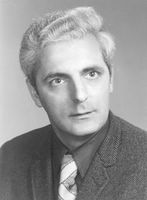By Frank Houston (from Salon.com)
In 1955, four years after the theremin's eerily weepy sound was employed in "The Day the Earth Stood Still," RCA introduced the first modern synthesizer. The machine made sounds by manipulating electrical waves to denote timbre, pitch and volume. Like early computers, it filled a room and was tended by men in lab coats.A few years later Robert Moog, a graduate student in physics at Cornell University, published a magazine article explaining how to build a theremin, offering do-it-yourself kits for $49.95. Orders poured in, and Moog sold 1,000 that year. "We had $13,000 in the bank," he recalled recently, "a humongous cache of wealth for a graduate student back then!" The windfall enabled a career that helped bring electronic music out of the realm of novelty acts and university labs. A decade after the first RCA machine, Moog introduced the first widely adopted electronic instrument -- the synthesizer that bears his name.
When Moog (rhymes with "vogue") unveiled the Moog music synthesizer in 1965, his engineering skills combined with a bit of business luck to radically change the way music was made. Synthesizers went from being computers to instruments that could be found in any music store. The flowering of rock music may have come via Leo Fender, Les Paul and the Gibson Guitar Co., but the innovative music of the early 21st century owes far more to Moog and his imitators and successors.
Growing up in the '40s in Flushing, Queens, Moog suffered the usual cruelties boys inflict on the smarter, more introverted members of their tribe: "I was the class brain," he recalled in one of several e-mail interviews. "I knew I was smarter than they were, so they felt compelled to beat me up periodically to keep me in my place." He spent a lot of time with his father, who liked to dabble in electronics, and started his own electronics projects. He built his first theremin with the help of a hobby-magazine article at age 14. "I was hooked," he recalled. Five years later, Moog published his own do-it-yourself theremin article.
Moog's mother, meanwhile, gave him piano lessons and made him practice hours every day in the hope that he'd become a concert pianist, "klopping" him if he "didn't practice right." He found refuge in New York's prestigious Bronx High School of Science, where he "actually had some friends who were as nerdy as I was." Later, at Queens College, Moog finally developed what he called "a medical-minimum amount of social grace," and even started dating.
After getting some exposure to the liberal arts at Columbia University's Engineering School, Moog began graduate education in the engineering physics department of Cornell University. He took eight years to get his Ph.D., largely because of his part-time hobby: building theremins and other electronic instruments. The degree came in 1965, a year after Moog launched his synthesizer business.
Moog built his synthesizer in 1964 after a composer told him about the need for user-friendly electronic instruments utilizing new solid-state technology. The Moog was modular: You used patch cords to select your waveform (the sound's timbre) and frequency (pitch), and plugged in the interface -- a keyboard, instead of the binary code on paper that had defined the first RCAs. Moog's engineering wizardry did the rest.
RCA synthesizers, intended for an elite market of labs financed by universities and record companies, had cost $100,000 and up. In 1967 the new Moog sold for $11,000. It wasn't the only synthesizer around; many experts also commend Donald Buchla's modular synthesizer, built around the same time. But the Moog became prized for its utility and elegance, making Moog the name that brought synthesized music to the masses.
The Moog's biggest break came in 1969, when musician Walter (now Wendy) Carlos had a huge, Grammy-winning hit with "Switched-on Bach," popularizing electronic music with Moog-made renditions of Johann Sebastian Bach. Canadian pianist and Bach interpreter Glenn Gould said that Carlos' Fourth Brandenburg Concerto was "the finest performance of any of the Brandenburgs -- live, canned or intuited -- that I've ever heard."
The Beatles introduced a new Moog in the majestic "Because," on "Abbey Road," the last album they recorded. The instrument was somehow perfectly suited to the layered, atmospheric vocals and John Lennon's ethereal lyrics. In 1971, Carlos brought the Moog to cinema, scoring Stanley Kubrick's "A Clockwork Orange" with electronic Beethoven whose gleeful perversity helped lend the movie its malevolent sheen.
Still, these were products of studio recording. It took musicians with a talent for excess -- such as keyboardist Keith Emerson -- to tote the enormous Moog setup, a towering box of electronics, onto the stage for live shows. Ever mindful of utility, Moog next introduced the portable, performance-minded Minimoog. Rock-oriented musicians like Jan Hammer showed that the synthesizer could be used as an expressive lead instrument. Jazzers like Josef Zawinul used the instrument to "add new colors to the traditional sound world of jazz," says Doug Keislar, editor of the Computer Music Journal.
"It was really the advent of the Minimoog that saw synthesizers take off," Keislar says. "The Minimoog showed that there was a significant market for portable, cheaper synthesizers." Or as Moog put it, in typically dry fashion, "By 1974 or so, having a Minimoog would make it a lot easier to get a job playing the local Ramada Inn."
A century after Thomas Edison reproduced the first recorded sound, the synthesizer began to spread into musical genres from the avant-garde to jazz. In 1977, the instrument took a central role in emerging forms of electronic music, with Donna Summer's hit dance single, "I Feel Love," created almost entirely on Moog synthesizers, and German band Kraftwerk's "Trans Europe Express," an album of purely technological music.
On Aug 21, 2005 Bob Moog passed away. He was a gentle and humble man with a wonderful sense of humor and a brilliance that inspired millions around the world.

